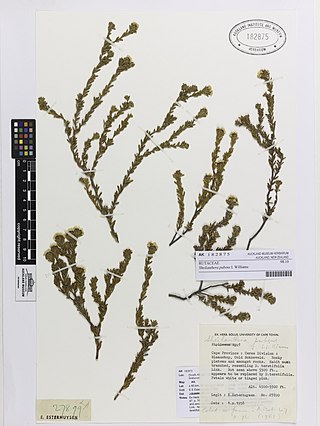
Hermann Wilhelm Rudolf Marloth was a German-born South African botanist, pharmacist and analytical chemist, best known for his Flora of South Africa which appeared in six superbly illustrated volumes between 1913 and 1932. This botanist is denoted by the author abbreviation Marloth when citing a botanical name.

Moritz Kurt Dinter was a German botanist and explorer in South West Africa.

Hans Schinz was a Swiss explorer and botanist who was a native of Zürich.

Titanopsis is a genus of about 10 species of succulent plants of the family Aizoaceae, indigenous to the arid regions of South Africa and Namibia.
Vanzijlia is a genus of flowering plants belonging to the family Aizoaceae. It only contains one known species, Vanzijlia annulata.

Titanopsis calcarea, commonly called the jewel plant, is a species of ice plant in the genus Titanopsis, native to South Africa. A succulent, it has gained the Royal Horticultural Society's Award of Garden Merit as an ornamental.
Hammeria is a genus of flowering plants belonging to the family Aizoaceae.
Gerardiina is a genus of flowering plants belonging to the family Orobanchaceae.
Jacobsenia is a genus of flowering plants belonging to the family Aizoaceae.
Kalbreyeriella is a genus of flowering plants belonging to the family Acanthaceae.
Leipoldtia is a genus of flowering plants belonging to the family Aizoaceae.
Moquiniella is a monotypic genus of flowering plants belonging to the family Loranthaceae. It only contains one known species, Moquiniella rubra(A.Spreng.) Balle
Mossia is a monotypic genus of flowering plants belonging to the family Aizoaceae. It only contains one known species, Mossia intervallaris.

Stoeberia is a genus of flowering plants belonging to the family Aizoaceae.

Schlechteranthus is a genus of flowering plants belonging to the family Aizoaceae.
Ruelliopsis is a monotypic genus of flowering plants belonging to the family Acanthaceae. It only contains one known species, Ruelliopsis setosa(Nees) C.B.Clarke
Polemanniopsis is a genus of flowering plants belonging to the family Apiaceae.

Sheilanthera is a monotypic genus of flowering plants belonging to the family Rutaceae. The only known species is Sheilanthera pubens.
Krauseola is a genus of flowering plants belonging to the family Caryophyllaceae.
Neesenbeckia is a monotypic genus of flowering plants belonging to the family Cyperaceae. The only species is Neesenbeckia punctoria(Vahl) Levyns.






